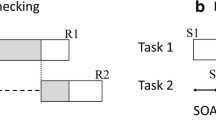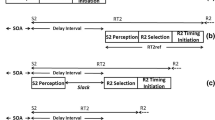Abstract
It has been argued that the psychological refractory period (PRP) effect is eliminated with two ideomotor compatible tasks when instructions stress fast and simultaneous responding. Three experiments were conducted to test this hypothesis. In all experiments, Task 1 required spatially compatible manual responses (left or right) to the direction of an arrow, and Task 2 required saying the name of the auditory letter A or B. In Experiments 1 and 3, the manual responses were keypresses made with the left and right hands, whereas in Experiment 2 they were left–right toggle-switch movements made with the dominant hand. Instructions that stressed response speed reduced reaction time and increased error rate compared to standard instructions to respond fast and accurately, but did not eliminate the PRP effect on Task 2 reaction time. These results imply that, even when response speed is emphasized, ideomotor compatible tasks do not bypass response selection.





Similar content being viewed by others
Notes
In Lien et al.’s (2002) study, the interval varied as a function of the subject’s reaction time, the time for the experimenter to enter the identity of the vocal response into the computer, and whether error feedback of 1,000 ms was provided.
Using the notation illustrated in Fig. 1, the central bottleneck model makes a simple prediction for RT2 at short SOAs and long SOAs. Assuming that a bottleneck delay occurs on every trial at short SOAs but never at long SOAs,
$${\rm RT2}_{\text{(long SOA)}} = 2A + 2B +2C$$$${\rm RT2}_{\text{(short SOA)}} = 1A + 1B + 2B + 2C - {\rm SOA} = {\rm RT1} - 1C + 2B + 2C - {\rm SOA}.$$Therefore,
$${\rm PRP} = {\rm RT2}_{\text{(short SOA)}} - {\rm RT2}_{\text{(long SOA)}} = 1A + 1B - 2A - {\rm SOA}.$$It follows that,
$${\rm PRP} =RT1 - 1C - 2A - {\rm SOA}.$$
References
Greenwald, A. G. (2003). On doing two things at once: III. Confirmation of perfect timesharing when simultaneous tasks are ideomotor compatible. Journal of Experimental Psychology: Human Perception and Performance, 29, 859–868.
Greenwald, A. G. (2005). A reminder about procedures needed to reliably produce perfect timesharing: Comment on Lien, McCann, Ruthruff, and Proctor (2005). Journal of Experimental Psychology: Human Perception and Performance, 31, 221–225.
Greenwald, A.G., & Shulman, H.G. (1973). On doing two things at once: II. Elimination of the psychological refractory period effect. Journal of Experimental Psychology, 101, 70–76.
Hazeltine, E., Teague, D., & Ivry, R. B. (2002). Simultaneous dual-task performance reveals parallel response selection after practice. Journal of Experimental Psychology: Human Perception and Performance, 28, 527–545.
Lien, M.-C., & Proctor, R. W. (2002). Stimulus-response compatibility and psychological refractory period effects: Implications for response selection. Psychonomic Bulletin & Review, 9, 212–238.
Lien, M.-C., Proctor, R. W., & Allen, P. A. (2002). Ideomotor compatibility in the psychological refractory period effect: 29 years of oversimplification. Journal of Experimental Psychology: Human Perception and Performance, 28, 396–409.
Lien, M.-C., Proctor, R. W., & Ruthruff, E. (2003). Still no evidence for perfect timesharing with two ideomotor-compatible tasks: A reply to Greenwald (2003). Journal of Experimental Psychology: Human Perception and Performance, 29, 1267–1272.
Lien, M.-C., McCann, R. E., Ruthruff, E., & Proctor, R. W. (2005). Dual-task performance with ideomotor compatible tasks: Is the central processing bottleneck intact, bypassed, or shifted in locus? Journal of Experimental Psychology: Human Perception and Performance, 31, 122–144.
Lien, M.-C., Ruthruff, E., & Johnston, J. C. (2006). Attentional limitations in doing two things at once: The search for exceptions. Current Directions in Psychological Science (in press).
Meyer, D. E., & Kieras, D. E. (1997). A computational theory of executive cognitive processes and multiple-task performance: Part 2. Accounts of psychological refractory-period phenomena. Psychological Review, 104, 749–791.
Navon, D., & Miller, J. (2002). Queuing or sharing? A critical evaluation of the single-bottleneck notion. Cognitive Psychology, 44, 193–251.
Pashler, H. (1993). Dual-task interference and elementary mental mechanisms. In D. Meyer, & S. Kornblum (Eds.), Attention and performance XIV: Synergies in experimental psychology, artificial intelligence, and cognitive neuroscience (pp. 245–264). Cambridge, MA: MIT Press.
Pashler, H. (1994). Dual-task interference in simple tasks: Data and theory. Psychological Bulletin, 116, 220–244.
Pashler, H. (1998). The psychology of attention. Cambridge, MA: MIT Press.
Pashler, H., & Johnston, J. C. (1998). Attentional limitations in dual-task performance. In H. Pashler (Ed.), Attention (pp. 155–189). Hove, UK: Psychology Press.
Pashler, H., & O’Brien, S. (1993). Dual-task interference and the cerebral hemispheres. Journal of Experimental Psychology: Human Perception and Performance, 19, 315–330.
Posner, M. I., & Boies, S. J. (1971). Components of attention. Psychological Review, 78, 391–408.
Posner, M. I., Klein, R., Summers, J., & Buggie, S. (1973). On the selection of signals. Memory & Cognition, 1, 2–12.
Prinz, W. (1987). Ideo-motor action. In H. Heuer, & A. F. Sanders (Eds.), Perspectives on perception and action (pp. 47–76). Hillsdale, NJ: Erlbaum.
Ratcliff, R., & Smith, P. L. (2004). A comparison of sequential sampling models for two-choice reaction time. Psychological Review, 111, 333–367.
Ruthruff, E., Johnston, J. C., & Van Selst, M. (2001). Why practice reduces dual-task interference. Journal of Experimental Psychology: Human Perception and Performance, 27, 3–21.
Ruthruff, E., Johnston, J. C., Van Selst, M., Whitsell, S., & Remington, R. (2003). Vanishing dual-task interference after practice: Has the bottleneck been eliminated or is it merely latent? Journal of Experimental Psychology: Human Perception and Performance, 29, 280–289.
Schumacher, E. H., Seymour, T. L., Glass, J. M., Fencsik, D. E., Lauber, E. J., Kieras, D. E., & Meyer, D. E. (2001). Virtually perfect time sharing in dual-task performance: Uncorking the central cognitive bottleneck. Psychological Science, 12, 101–108.
Tombu, M., & Jolicœur, P. (2002). All-or-none bottleneck versus capacity sharing accounts of the psychological refractory period phenomenon. Psychological Research, 66, 274–286.
Tombu, M., & Jolicœur, P. (2003). A central capacity sharing model of dual-task performance. Journal of Experimental Psychology: Human Perception and Performance, 29, 3–18.
Tombu, M., & Jolicœur, P. (2004). Virtually no evidence for virtually perfect time-sharing. Journal of Experimental Psychology: Human Perception and Performance, 30, 795–810.
Van Selst, M., Ruthruff, E., & Johnston, J. C. (1999). Can practice eliminate the psychological refractory period effect? Journal of Experimental Psychology: Human Perception and Performance, 25, 1268–1283.
Van Zandt, T., Colonius, H., & Proctor, R. W. (2000). A comparison of two response time models applied to perceptual matching. Psychonomic Bulletin & Review, 7, 208–256.
Welford, A. T. (1952). The “Psychological refractory period” and the timing of high speed performance—A review and a theory. British Journal of Psychology, 43, 2–19.
Author information
Authors and Affiliations
Corresponding author
Rights and permissions
About this article
Cite this article
Shin, Y.K., Cho, Y.S., Lien, MC. et al. Is the psychological refractory period effect for ideomotor compatible tasks eliminated by speed-stress instructions?. Psychological Research 71, 553–567 (2007). https://doi.org/10.1007/s00426-006-0066-2
Received:
Accepted:
Published:
Issue Date:
DOI: https://doi.org/10.1007/s00426-006-0066-2




